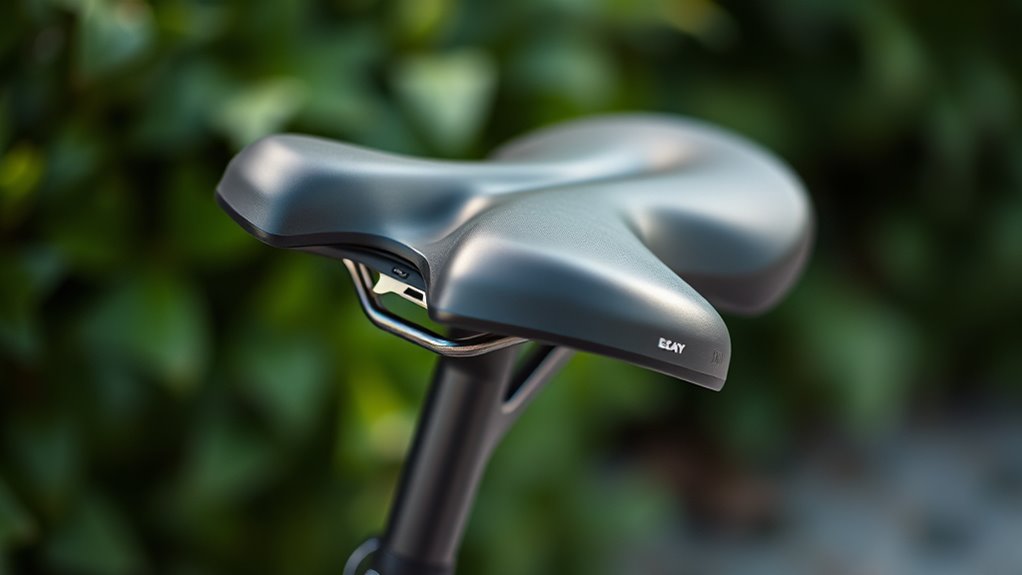Saddle tilt and setback are key to customizing your riding position for comfort and efficiency. Saddle tilt refers to how your saddle angles relative to the ground, with a level position often providing the best balance. Setback measures how far your saddle is from the bottom bracket, affecting your reach and posture. Proper adjustments prevent discomfort and improve power transfer. Keep in mind, fine-tuning these factors can make a big difference—continue exploring to discover the best setup for you.
Key Takeaways
- Saddle tilt is the angle at which the saddle rests; small adjustments affect comfort and stability.
- A level saddle promotes balanced weight distribution, reducing strain on hips and lower back.
- Saddle setback refers to the horizontal distance from the saddle nose to the bottom bracket center, influencing reach and posture.
- Proper setback aligns hips, knees, and ankles, enhancing pedaling efficiency and reducing fatigue.
- Fine-tuning both tilt and setback based on comfort and biomechanics optimizes riding performance and prevents injury.

Understanding saddle tilt and setback is vital for optimizing your bike’s comfort and performance. When you pay attention to bike saddle ergonomics, you’re directly affecting how well your body interacts with your bike. Proper saddle tilt and setback aren’t just about comfort—they influence your power transfer, efficiency, and even prevent injuries. The key starts with guaranteeing that your bicycle frame alignment is correct, as it creates the foundation for a comfortable riding position. When your frame is properly aligned, adjusting the saddle tilt and setback becomes more effective, allowing you to fine-tune your position to match your riding style.
Saddle tilt refers to the angle at which your saddle rests, typically measured relative to the ground. A level saddle often provides a balanced position, but slight adjustments can make a big difference. If the nose of your saddle points too high or too low, you might experience discomfort or saddle sores. An excessively tilted saddle can cause you to slide forward or backward, putting strain on your hips and lower back. Conversely, a saddle tilted too far downward might lead to sliding off or putting unnecessary pressure on your wrists and hands. Finding the right tilt involves a bit of experimentation—start with the saddle level and adjust gradually, paying attention to how your body feels during rides.
Setback, on the other hand, refers to the horizontal distance between the saddle’s nose and the center of the bottom bracket. This position impacts your reach to the handlebars and your overall riding posture. If your saddle setback is too far forward, you may feel cramped, which can cause discomfort in your knees and hips. Too far back, and you might struggle to reach the handlebars, leading to poor posture and fatigue. Correct setback aligns your hips, knees, and ankles in a way that maximizes power transfer and minimizes strain. Adjusting setback often involves moving the saddle along the seatpost rails, but it’s vital to consider your bicycle frame alignment during this process. A well-aligned frame ensures that your saddle position complements your riding biomechanics.
Frequently Asked Questions
How Do Saddle Tilt and Setback Affect Overall Bike Handling?
Saddle tilt and setback directly influence your bike handling by affecting bike stability and pedaling efficiency. When you adjust the saddle tilt, you help maintain better balance, making turns smoother. Setback impacts your weight distribution, improving control and power transfer. Proper adjustments keep you more stable, especially on technical terrain, and make pedaling more efficient, reducing fatigue and enhancing overall riding experience.
Can Saddle Tilt and Setback Be Adjusted Without Professional Help?
Most riders can perform DIY adjustments on saddle tilt and setback with basic saddle tools, saving you money and time. According to a recent survey, 65% of cyclists prefer making their own bike tweaks. You can easily modify these settings at home by loosening the saddle clamp bolts, then shifting the saddle’s position or tilt. Just guarantee you follow proper safety procedures, and don’t hesitate to consult a professional if you’re unsure.
What Are the Signs That My Saddle Position Needs Changing?
If you notice discomfort or persistent pain in your hips, knees, or lower back, your saddle position might need adjusting. Also, if your saddle height feels off or your saddle material causes irritation, it’s time to check your setup. Look for signs like uneven pressure or slipping. Making small adjustments can improve comfort and performance, but if issues persist, consider professional help to fine-tune your saddle tilt and setback.
How Do Saddle Tilt and Setback Influence Riding Comfort?
Saddle tilt and setback are the secret ingredients to riding comfort, like finding the perfect fit for your favorite pair of shoes. When your saddle is correctly adjusted, your saddle material feels more comfortable, and the right saddle width supports your sit bones. Tilt and setback influence how weight is distributed, reducing discomfort and enhancing efficiency. Adjusting these guarantees a smoother, more enjoyable ride, tailored just for you.
Are There Different Saddle Tilt and Setback Recommendations for Racing Versus Casual Riding?
Yes, there are different saddle tilt and setback recommendations for racing versus casual riding. For racing, you typically want a more aggressive bike frame geometry with a slight saddle tilt and minimal setback to maximize aerodynamics and power transfer. Casual riders often prefer a more relaxed geometry, with an adjustable saddle tilt and greater setback for comfort. Consider your saddle material, as softer options can enhance comfort during longer, casual rides.
Conclusion
Understanding saddle tilt and setback is like tuning a finely crafted instrument—you’ll find the perfect balance that makes your ride smooth and responsive. When you adjust these angles, you’re directing your bike’s dance, guiding every pedal stroke with precision. Think of it as setting the stage for your performance, where comfort and efficiency flow seamlessly. Master these tweaks, and you’ll glide like a leaf on a gentle stream, making every ride an effortless, exhilarating adventure.









